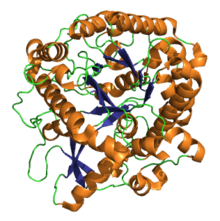Our website is made possible by displaying online advertisements to our visitors.
Please consider supporting us by disabling your ad blocker.
Myrosinase
| Thioglucosidase (Myrosinase) | |||||||||
|---|---|---|---|---|---|---|---|---|---|
 | |||||||||
| Identifiers | |||||||||
| EC no. | 3.2.1.147 | ||||||||
| CAS no. | 9025-38-1 | ||||||||
| Databases | |||||||||
| IntEnz | IntEnz view | ||||||||
| BRENDA | BRENDA entry | ||||||||
| ExPASy | NiceZyme view | ||||||||
| KEGG | KEGG entry | ||||||||
| MetaCyc | metabolic pathway | ||||||||
| PRIAM | profile | ||||||||
| PDB structures | RCSB PDB PDBe PDBsum | ||||||||
| Gene Ontology | AmiGO / QuickGO | ||||||||
| |||||||||
Myrosinase (EC 3.2.1.147, thioglucoside glucohydrolase, sinigrinase, and sinigrase) is a family of enzymes involved in plant defense against herbivores, specifically the mustard oil bomb. The three-dimensional structure has been elucidated and is available in the PDB (see links in the infobox).
A member of the glycoside hydrolase family, myrosinase possesses several similarities with the more ubiquitous O-glycosidases.[2][3] However, myrosinase is the only known enzyme found in nature that can cleave a thio-linked glucose. Its known biological function is to catalyze the hydrolysis of a class of compounds called glucosinolates.[4]
- ^ Burmeister WP, Cottaz S, Rollin P, Vasella A, Henrissat B (December 2000). "High resolution X-ray crystallography shows that ascorbate is a cofactor for myrosinase and substitutes for the function of the catalytic base". The Journal of Biological Chemistry. 275 (50): 39385–39393. doi:10.1074/jbc.M006796200. PMID 10978344.
- ^ Halkier BA, Gershenzon J (2006). "Biology and biochemistry of glucosinolates". Annual Review of Plant Biology. 57: 303–333. doi:10.1146/annurev.arplant.57.032905.105228. PMID 16669764.
- ^ Bones AM, Rossiter JT (June 2006). "The enzymic and chemically induced decomposition of glucosinolates". Phytochemistry. 67 (11): 1053–1067. doi:10.1016/j.phytochem.2006.02.024. PMID 16624350.
- ^ Shikita M, Fahey JW, Golden TR, Holtzclaw WD, Talalay P (August 1999). "An unusual case of 'uncompetitive activation' by ascorbic acid: purification and kinetic properties of a myrosinase from Raphanus sativus seedlings". The Biochemical Journal. 341 ( Pt 3) (3): 725–732. doi:10.1042/0264-6021:3410725. PMC 1220411. PMID 10417337.
Previous Page Next Page


